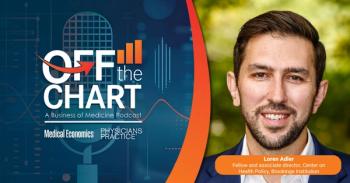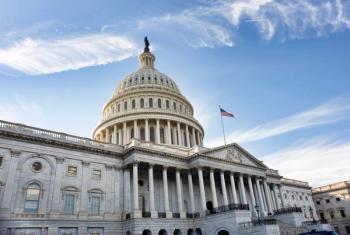
2017 Best States to Practice: The Top Five
Why Mississippi, Texas, Alaska, California, and Arkansas stand above the rest in terms of being the "Best States to Practice."
For more than a decade, Physicians Practice has examined practice conditions in every U.S. state, ranking the best states for physicians to either set up their own shop or become employed.
It is an often duplicated exercise by other publications, but an important one nonetheless.
With rising rates of physician burnout, changing state legislation governing healthcare, and numerous other factors weighing heavily on the profession, many doctors are looking for a change to continue practicing medicine. And for some, a change of location is sometimes the answer.
So this year, as we’ve done in the past, we’ve scoured publicly available data on everything from how expensive it is to live in a state to how many peers also call that location home. We then use an algorithm to “rank” the states that have the most attractive features for physicians.
METHODOLOGY
For our 2017 analysis, we utilized the latest data for cost of living, tax climate (state collections per capita), physician density, and Medicare's Geographic Practice Cost Index (which adjusts physician reimbursement based on regional variation in the cost to treat patients).
For the second year in a row, we partnered with Doximity to utilize their “Residency Navigator” to tell us post-residency retention rate by state, from one to nine years following completion of residency training.
This year, we also partnered with medical malpractice specialists Cunningham Group for malpractice premium averages. And these are true averages as every physician knows malpractice premiums can vary by specialty and the specific city you practice in.
What our metrics don’t capture are things like collegiality of the healthcare community, the local arts and entertainment scene, or access to various recreational activities. So to add a little more commentary to the numbers, Physicians Practice spoke to physicians in the five states that ranked the highest this year in terms of being physician friendly. They are (in order): Mississippi, Texas, Alaska, California, and Arkansas.
MISSISSIPPI
The state of Mississippi is known for two things: beautiful Magnolia blossoms and generous hospitality. The latter can be seen in the state's physicians, according to Katherine Patterson, MD of the Indianola Family Medical Group in Indianola, Miss.
"We have a genuinely caring population of physicians. If we're from Mississippi, we are very proud to be from Mississippi and we want to take very good care of the patients that live in our state," says Patterson.
And Mississippi seems like a friendly place for physicians, according to this year's Best States to Practice data. The state finished in the top 10 of all six metrics five times, the most of any other state.
Growing up, Patterson was a military child, living in different locations throughout the southeast before her parents ultimately settled down in Hattiesburg. Patterson, a family physician and obstetrician, has been practicing in Indianola since 2007.
Living close to her family, the state’s actions toward tort reform, and helping underserved communities are just a few of the reasons Patterson continues to practice in Mississippi. "When patients [in Mississippi] find a physician they feel they identify with, they establish a relationship. That relationship can go on for as long as the physician or patient lives … our patient population is hungry for that long-lasting therapeutic relationship with a physician," says Patterson.
Furthermore, being a family physician has given Patterson a great appreciation for Mississippi's strict vaccine laws. "We have a very high rate of vaccination of children. Because of this, we don't see many outbreaks of diseases that other states have seen," says Patterson.
When she is not practicing medicine, Patterson enjoys the beautiful state parks, lakes, and coastline that Mississippi has to offer. "My children, husband, and I also like to go to sporting events. We have two Southeastern Conference [college] teams here in Mississippi and football is really big," says Patterson.
"From music, to art and food, Mississippi has a rich history,” she says. “People travel from all over the country to visit the BB King Museum," located in Indianola.
TEXAS
As the saying goes, Carlos Cardenas, MD, is Texas born, Texas bred, and when he passes, he'll be Texas dead.
The gastroenterologist from Edinburg, Texas, and president of the Texas Medical Association (TMA) was born and raised in southern Texas, not far from the Mexico border. His family goes back many generations in the area. After he finished residency (also in Texas), it was an easy decision for him to stay.
"It would have taken six teams of horses to keep me from coming home," he says. "I've always been pretty provincial when it came time to make those kinds of decisions.
For Cardenas, Texas is a top place to practice medicine because of its pro-business attitude. He credits the TMA for helping reduce regulations that make it friendlier for physicians to open up a practice in the state. "Texas still has a large number of physicians in solo practices or small group practices," he notes.
Cardenas specifically cites the organization’s work in improving the tort environment for physicians and patients. To this point, the state placed seventh in malpractice premium average in this year's Best States to Practice ranking. It also ranked high in residency retention, physician density, and cost of living. In Texas,
From a non-clinical standpoint, Cardenas praises the state's cultural richness and diversity, particularly in terms of integrating Hispanic heritage. He also says it has a nice mix of rural and urban communities, making it appealing for different physician interests.
"If you want to serve the underserved … physicians will find opportunity to do that. We have new medical schools that have come online that are available to folks with an academic interest. There is a growing research interest in the state, which is very important," he says.
ALASKA
In 2004, having already established himself as an internist in the states of Texas and Washington, J. Ross Tanner, DO, FACP, was giving a speech in Alaska on a chilly February day. Between the breathtaking views of the mountains covered in snow, the fresh sushi and the state’s need for a diabetes specialist, he had a feeling he was destined for “The Last Frontier.”
“I really looked at what would enrich my family and my profession … and Alaska was it,” says Tanner.
The following year, Tanner relocated to the state and soon after became the first physician in the state to become a lipidologist (cholesterol specialist). He’s since held leadership positions with the Alaska State Medical Association and continues to be an advocate for practicing in the state.
For the first time since Physicians Practice began ranking “Best States to Practice,” Alaska finished in the top five states, thanks to its favorable Medicare Geographic Practice Cost Index, its low tax collection and the third highest residency retention rate in the U.S.
Tanner says the WWAMI project, where pre-medical students from the University of Washington train in that state, Wyoming, Alaska, Montana and Idaho (comprising the program’s acronym), helps bring docs to Alaska who have trained in roles in primary care. Many students, said Tanner, remain in the region to practice medicine once they are exposed to the culture in the state.
“It’s a great program where they get so much support and help the communities, that they then come back [to practice], so we are more likely to keep those who go to medical school in Alaska here because of that experience,” he says.
Tanner appreciates the availability of the great outdoors, from skiing less than an hour away from home, to the ability to fish for salmon near his office. He also appreciates that Alaska has fewer of the problems of the lower 48 states, with an abundance of private practice opportunities and smaller rates of burnout.
“It’s all about finding the joy in medicine,” he says, “and for me, it’s here.”
CALIFORNIA
Newly minted president of the California Medical Association (CMA), otolaryngologist Ted Mazer, MD, has worked at his San Diego-based practice for 29 years.
Having grown up in New York and attended the University of Buffalo for his undergraduate studies, moving to a more forgiving climate was tops on his list when he made the decision to relocate in 1988. "Weather was certainly an attraction for me. I [also] thought it was a great opportunity to practice in a high-tech area with good hospitals, good equipment, and I wanted to be somewhere at the forefront of medicine," says Mazer.
In this year's Physicians Practice ranking, California finished in the top ten of all states three times, with high marks in residency retention, a favorable Medicare GCPI, and malpractice premiums.
For Mazer, California is a great state to practice medicine because it is an ideal place to live first and foremost, with a good educational system and an endless number of leisure activities. "Boating, skiing, hiking, mountain climbing, you name it, California has it. I'm in San Diego, so I cannot talk so positively about sports teams these days, but that's here too for most of the state," says Mazer.
When it comes to a clinical perspective, Mazer points to the large number of medical schools with residency programs generating the next generation of physicians who are eager to use new technology and participate in advocacy like he has never witnessed before.
"This is a very bright group of students who always seem to have more than medicine on their mind," says Mazer, who enjoys speaking to medical students often through his work with the CMA.
Furthermore, Mazer believes California is ahead of other states when it comes to the intensity and willingness of its younger physicians.
"I get a lot of interaction with other state medical societies through my involvement with the American Medical Association and there are a few that have intensity with their young physicians, but I don't think it's anything close to what I see in California. I'm encouraged we have a good future here when it comes to the leadership of medicine," says Mazer.
Mazer credits California's diverse population of backgrounds and cultures with making the practice of medicine unique to the state. "We have pathology that you don't see in less diverse states. You have both the challenge and the fun of dealing with people in different languages. This is all part of the excitement of practicing medicine," says Mazer.
ARKANSAS
Amy Cahill, MD, was born and raised in Pine Bluff, Arkansas, and it’s currently where she practices medicine. For the past 18 years, Cahill has owned and operated Genesis Center for Women, located on the campus of Jefferson Regional Medical Center, and she can’t imaging leaving the state.
From the close family ties-her parents live less than a mile away-to her 10-minute commute to the nearest fishing lake, she plans to stay in The Natural State for a while. “If I want to make [hospital rounds], I walk to the hospital from my office,” says Cahill. “Less travel time makes for more life time.”
In this year’s rankings, Arkansas finished in the top 10 in terms of physician density, cost of living and residency retention, all things Cahill demonstrates. She left Pine Bluff for 12 years to study down the road in Little Rock at the University of Arkansas and says her small state allows her to know many of her colleagues and patients extremely well.
She currently serves as the president of the Arkansas Medical Society, making connections there with peers as well as working with state legislators. Cahill notes that several politicians on the state level are either physicians or physician spouses. “We have a very good relationship with the state legislature and they actually ask us for our opinions on bills,” she says. “Together, we’ve created a climate that is more about helping patients than business.”
And if any doctors are looking for time in the great outdoors or a collegial place to practice medicine, Cahill says there’s still opportunity in Arkansas.
“We have a pretty significant number of hospital-employed doctors, but you can still be [in private practice] and do just fine,” she says. “We work hard to maintain a very physician-friendly climate so that it is possible to succeed in all practice environments.”
Newsletter
Optimize your practice with the Physicians Practice newsletter, offering management pearls, leadership tips, and business strategies tailored for practice administrators and physicians of any specialty.








